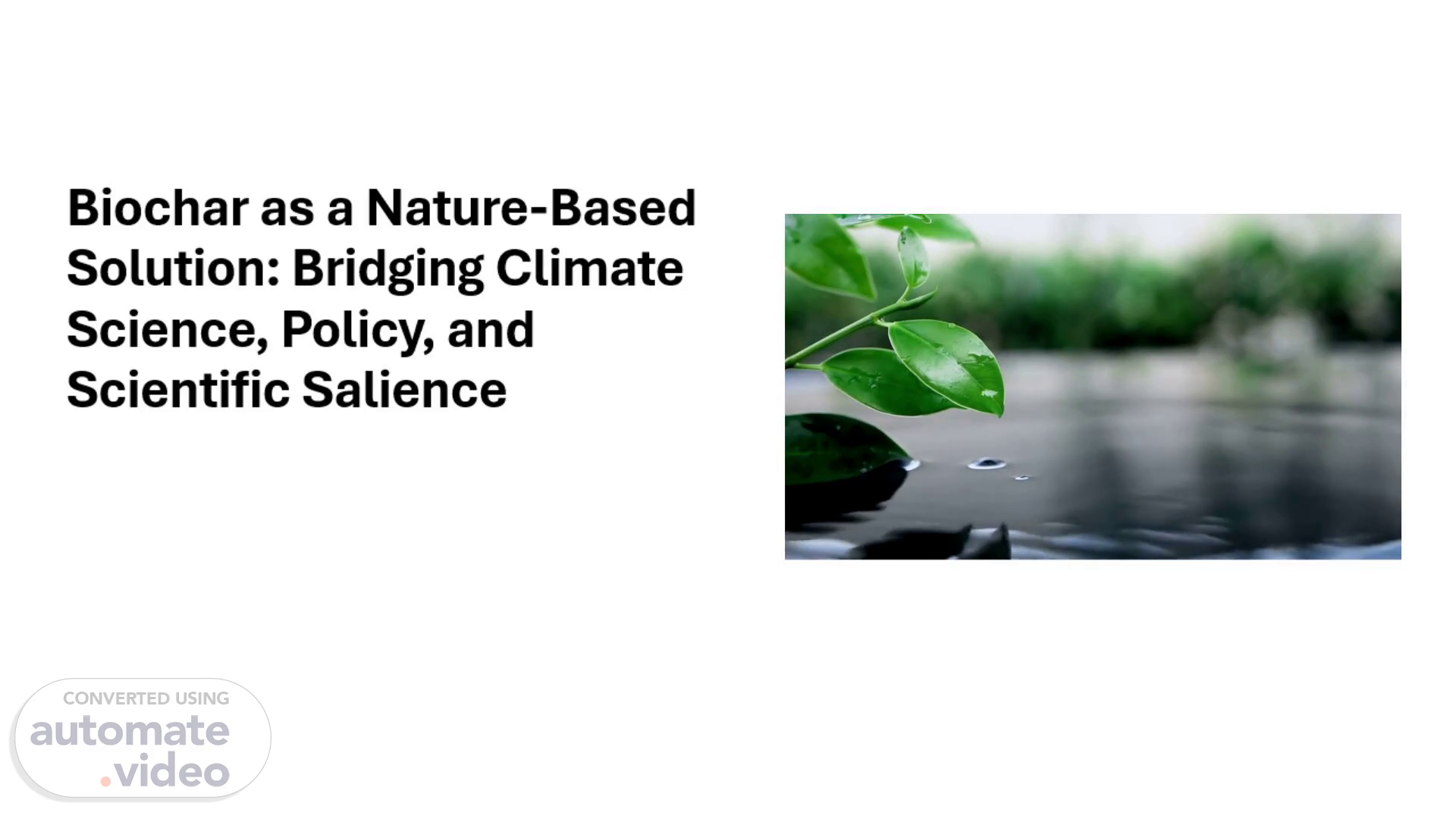
Biochar as a Nature-Based Solution: Bridging Climate Science, Policy, and Scientific Salience
Scene 1 (0s)
Water Drops And Ripple. Biochar as a Nature-Based Solution: Bridging Climate Science, Policy, and Scientific Salience.
Scene 2 (11s)
‘‘ Understanding the current connection between climate science and policy is crucial, as Biochar, a Nature-Based Solution, exemplifies how scientific innovation can inform actionable policies for climate change mitigation’’.
Scene 3 (41s)
INTRODUCTION. In the urgent search for effective climate change mitigation strategies, nature-based solutions have emerged as powerful tools that harness natural processes to address environmental challenges. Among these solutions, biochar stands out as a particularly promising yet underutilized approach that creates a critical link between climate science, policy frameworks, and practical implementation. This presentation explores how biochar functions as a nature-based solution, examines its scientific foundations, analyses its place in current policy landscapes and demonstrates its increasing salience in climate action strategies..
Scene 4 (1m 25s)
Understanding Biochar: Scientific Foundations. From a climate science perspective, biochar provides carbon sequestration by physically locking carbon in a stable matrix with residence times of 100 - 1,000+ years. It reduces emissions of nitrous oxide and methane from soils, avoids emissions from decomposing agricultural residues, and produces renewable energy co-products that can displace fossil fuels (Kammann et al., 2022). The IPCC Sixth Assessment Report identifies biochar as having a technical mitigation potential of 0.3-6.6 gigatons of CO₂-equivalent per year by 2050 (IPCC, 2022). Life cycle analyses indicate that each tonne of biochar can sequester between 0.5 and 2 tonnes of CO₂-equivalent, with removal costs ranging from $30- $120 per tonne—making it one of the more cost-effective carbon dioxide removal approaches currently available (National Academies of Sciences, Engineering, and Medicine, 2022)..
Scene 5 (3m 5s)
Beyond Carbon: The Multifunctional Benefits of Biochar.
Scene 6 (4m 22s)
The Evolving Policy Landscape for Biochar. The policy environment surrounding biochar has evolved significantly in recent years. At the international level, biochar aligns with the Paris Agreement's Article 5 call for enhancement of carbon sinks and reservoirs. The IPCC now explicitly recognizes biochar as a negative emission technology, and initiatives such as the 4 per 1000 program include biochar as a key soil carbon enhancement strategy. Carbon markets have also recognized biochar's value, with several voluntary standards now offering biochar methodologies. Notably, biochar carbon credits often command premium pricing ($50- 150/tonne) compared to other nature-based solutions due to their high measurability and permanence attributes (Carbon Direct, 2023)..
Scene 7 (4m 57s)
At national levels, policy integration is increasing. Australia's Emissions Reduction Fund includes biochar methodologies that allow projects to generate carbon credits. The United States' Growing Climate Solutions Act supports biochar as an agricultural carbon sequestration method. The European Union’s Carbon Farming Initiative incorporates biochar practices, and several countries, including Japan, China, and India, have begun to include biochar in their Nationally Determined Contributions under the Paris Agreement..
Scene 8 (5m 29s)
A diagram of a diagram of a policy AI-generated content may be incorrect..
Scene 9 (6m 4s)
Challenges and Knowledge Gaps. Despite its promise, several challenges remain. These include limited long-term field studies, the need for localized research to optimize application, inconsistent standardization of biochar quality, and variable life cycle assessment outcomes across different production systems. Policy challenges include incomplete regulatory frameworks in many jurisdictions, limited farmer education about biochar benefits, initial investment costs, and underdeveloped supply chains. Addressing these barriers requires coordinated research and policy development efforts..
Scene 10 (6m 27s)
Case Studies: Successful Implementation. The Stockholm Biochar Project : demonstrates a municipal-scale approach that converts urban green waste into biochar, utilizing the generated heat for the city's district heating system while using the biochar for urban trees and stormwater management. This award-winning project sequesters approximately 1,800 tonnes of CO₂-equivalent annually while solving multiple urban sustainability challenges (City of Stockholm, 2023)..
Scene 11 (6m 52s)
In Kenya, initiatives have trained over 50,000 smallholder farmers in biochar techniques, documenting crop yield increases of approximately 30% while generating carbon credit revenue shared with participating farmers. The project simultaneously addresses food security, soil degradation, and rural economic development while sequestering about 25,000 tonnes of CO₂-equivalent annually (ICRAF, 2023)..
Scene 12 (7m 17s)
[image] A blue and white wavy pattern AI generated content may be incorrect.
Scene 13 (7m 49s)
A row of coins with plants growing out of them AI-generated content may be incorrect..
Scene 14 (8m 29s)
THANK YOU. A person touching a green hexagon with a green arrow AI-generated content may be incorrect..
Scene 15 (8m 41s)
References. Carbon Direct. (2023). Carbon Credit Quality Assessment: Biochar Projects. New York: Carbon Direct Inc. City of Stockholm. (2023). Stockholm Biochar Project: Five Year Assessment Report. ICRAF (World Agroforestry Centre). (2023). Biochar Systems for Smallholders in Developing Countries: Leveraging Current Knowledge and Exploring Future Potential for Climate-Smart Agriculture. IPCC. (2022). Climate Change 2022: Mitigation of Climate Change. Contribution of Working Group III to the Sixth Assessment Report of the Intergovernmental Panel on Climate Change. Jeffery, S., Matu, F.K., Sohi, S.P., & Leake, J.R. (2023). A global meta-analysis of biochar's effects on crop productivity in diverse agricultural systems. Nature Communications, 14, 382. Kammann, C., Ippolito, J.A., Hagemann, N., Borchard, N., & Cayuela, M.L. (2022). Biochar as a tool to reduce the agricultural greenhouse-gas burden – knowns, unknowns and future research needs. Journal of Environmental Engineering and Landscape Management, 30(1), 1-29. National Academies of Sciences, Engineering, and Medicine. (2022). Negative Emissions Technologies and Reliable Sequestration: A Research Agenda. Washington, DC: The National Academies Press..